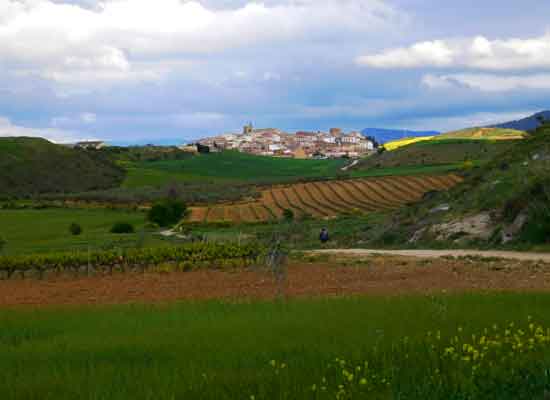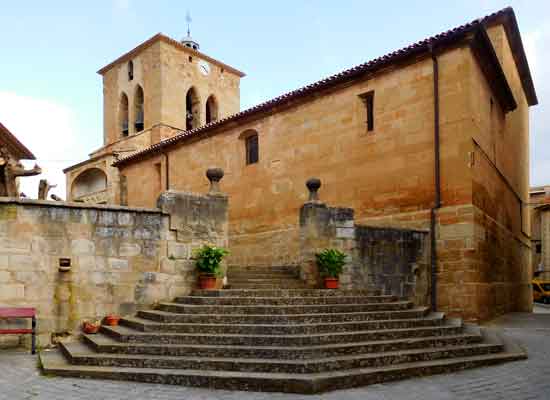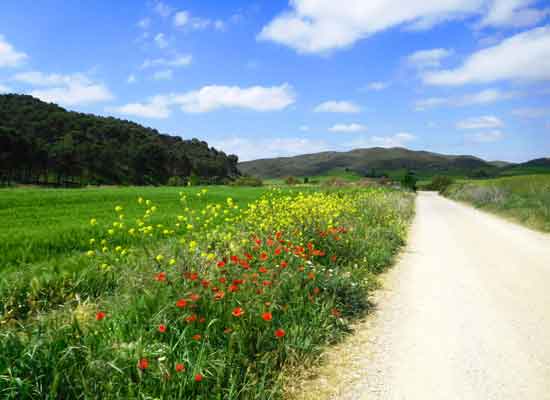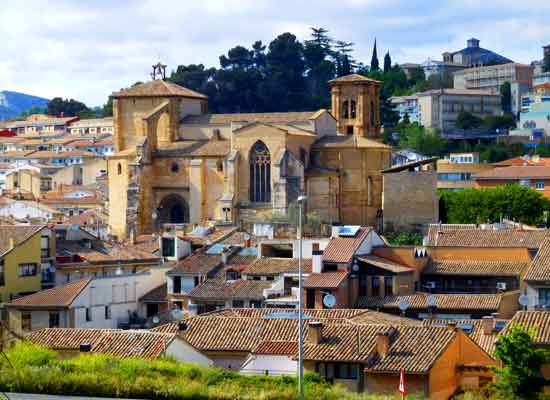Step by Step on The Way of Saint James
From Puente la Reina to Estella
15 May 2018
Stage 5 – 22 km

As happens most mornings, my journey along The Way begins in the company of other pilgrim friends, even though, as always, we end up scattering as we go along.
We leave the hostel at 7:15 and walk all the way down Calle Mayor.
We then cross the beautiful Romanesque bridge “with shoes on,” unlike the pilgrims of the past who traditionally left Puente la Reina barefoot.
Before leaving for good, I glance back one last time to admire the enchanting bridge.
After an hour of walking, I reach Mañeru. Without stopping, I take a quick look at the exterior of the Parroquia de San Pedro Apóstol, a neoclassical building dating back to the 18th century.
Passing through most of the small towns along The Way of Saint James, I’m always struck by the emptiness—it often feels as though these are ghost towns where people have vanished.
Yet, it’s clear that the houses are not abandoned. Many are renovated, with well-maintained exteriors and balconies adorned with flowers and plants.
And so I wonder: – Where are the people? What do they do? –
Even if most are out working, probably in the fields, surely someone must stay home for household chores, go shopping, or open the windows to let in fresh air. There must be elderly people who no longer work and children playing in the streets.
– Yet, nothing! –
Not a soul is seen, even in the late afternoon when work hours are long over.
– Perhaps I’m too much of a city dweller and can’t imagine what life in these rural villages must be like. –
***
Today, the weather is kind to us pilgrims: it’s not raining, and the sky is slightly cloudy, although the temperature is still low enough that I have to wear both my sweatshirt and windbreaker.
The landscape, with its gently rolling hills, is still dominated by vast wheat fields. Occasionally, vineyards start to appear—an early glimpse of the Rioja region’s signature scenery, which The Way will soon cross after leaving Navarra.

Around nine o’clock, I arrive in Cirauqui, a medieval village perched on a hill.
Its centre features the 13th-century iglesia de San Román, notable for its entrance portal with a rare ogival design and repeated lobes.
After leaving Cirauqui, I follow a short stretch of an ancient Roman road, where the original paving stones are still visible. Shortly after, I cross a Roman bridge.
A signpost here indicates that there are 676 kilometres to Santiago de Compostela; at the same time, it reminds me that I’ve already covered just over 100 kilometres.
I meet Anna, a wonderful French lady who speaks only French.
We try to chat a little, but since we can’t understand each other very well, we end up relying on big smiles, hugs, and a photo to seal our friendship.
I continue on my way, bidding her farewell with a cheerful – Buen camino! –


“Buen camino” is the universally recognised greeting among those walking the route to Santiago de Compostela.
Whether they’re from Taiwan, South America, or any other corner of the world, everyone learns and repeats this pilgrims’ greeting.
And then, though less frequently, two other words are heard along The Way—phrases once used by pilgrims and derived from Latin: “Ultreya” (onward) and “Suseya” (upward).
So, when a traveller in the past asked – Where are you heading, pilgrim? – the reply would be – Ultreya. – (I’m going forward), and the other would respond – Suseya! – (You’ll go upward, with God’s blessing).
***
At eleven o’clock, I pass through Lorca, another small village with a beautiful medieval church at its centre: the iglesia de San Salvador.
I continue without stopping.
The landscape is still marked by the vibrant green of wheat fields, dotted with yellow rapeseed flowers and red poppies.
Poppies, which line most of the paths along The Way, are my passion. Seeing them fills me with a sense of calm and slowness—just like the long journey I’m living.

I walk for another good hour and, at around 12:15, after crossing the Roman bridge over the Irantzu River, I arrive in Villatuerta.
The village is worth stopping at, especially to visit the Gothic iglesia de la Asunción. Its imposing structure, which resembles a fortress more than a church, stands out even more due to its location in the centre of a spacious square.
It’s open, so I take the opportunity to visit. A mass is in progress, so I sit quietly in one of the back pews to rest and observe the church. Among the religious scenes depicted in the beautiful Romanesque altarpiece, one showing a battle against the Moors catches my eye.

It is 13:30 when I arrive in Estella, the destination marking the end of today’s stage.
Entering the town along The Way, even before reaching the centre, I pass by the iglesia del Santo Sepulcro, built in Romanesque style during the 13th century.
I stop at the Albergue Municipal de Peregrinos, where I pay just 6 Euros for accommodation.
This time, as I’ve promised myself to do from now on, I haven’t booked ahead and find a spot without any issues.
I should point out, however, that reservations are only accepted by private hostels and never by municipal ones.
Today’s route has been very beautiful and, at the same time, easy to walk, as the terrain doesn’t involve any significant inclines.
The pleasantness of today’s walk is also due to the fine weather that accompanied me and the good condition of my body. Apart from the normal fatigue at the end of the stage due to the kilometres covered, I have no other complaints.
Many of the pilgrims I meet, however, report various problems, including blisters and tendinitis, which are very common.
I notice elastic bands wrapped around different parts of the body—knees, ankles, thighs, and sometimes even shoulders. Then there are those wide, colourful adhesive strips, frequently used by athletes, which I often see applied to walkers along The Way.
Pilgrims of the past certainly didn’t have the aids we have today.
Starting with footwear, the pilgrims of old didn’t wear technical shoes but walked in thin leather sandals, wrapping their feet with cloth strips, just as depicted in paintings and sculptures of ancient walkers.
***
Estella was founded around the mid-1200s, thanks to the pilgrims who passed through on their way to Santiago de Compostela. The steady flow of people encouraged the growth of commerce and, consequently, the expansion of the settlement.
In the afternoon, along with Paolo from Bergamo, I stroll through the historic centre of the town.
From Calle San Nicolás, a wide and long outdoor staircase leads up to the medieval iglesia de San Pedro de la Rúa. Its entrance portal features a distinctive ogival design with repeated lobes, one of only three such examples found along The Way. The church’s interior has three naves and houses an impressive rococo altarpiece. Adjacent to it is a beautiful Romanesque cloister with a square layout.
Next, we visit the iglesia Santa Maria Jus del Castillo, which has been converted into an Interpretation Centre for Romanesque art and The Way of Saint James after undergoing restoration.
We then head to the puente de la Cárcel over the río Ega, also known as the puente Picudo (pointed bridge) due to its very particular shape.
To finish our tour, we admire the convento de Santo Domingo from the outside. Today, it serves as a residence for the elderly.
For dinner, I join the usual group of fellow Italians, with Paolo joining us tonight as well.
We choose an Italian restaurant, even though I usually avoid places serving our national cuisine when abroad. The place is called Il Colosseo and, as it turns out, is owned by a Roman.
Naturally, the “pilgrim’s menu” is available here too. I opt for a chickpea soup, meat with potatoes, and fruit. The whole meal, including wine, costs just 10 Euros.
In the end, I don’t regret choosing the Italian restaurant, and I’m satisfied with the food I’ve eaten.
I wrap up the day with a chat with some Spanish friends and head to bed at 23:00.
| © Aldo Lardizzone 2020 |  |
CREATIVE COMMONS |



